The White Desert of India - Kutch

Virtually an island that resembles the shape of a tortoise, Kutch is an erstwhile princely state of India holding onto its grandeur nature from the past. Kutch is probably one of the most beautiful, yet surreal places in India with the vast expanses of the white salt desert. The place comes to life during the winters when the Rann Festival is held during December-February everywhere in which there are huge camp settlements with cultural programs, functions and adventure activities like hot-air ballooning.
Kutch is also famous for crafts and embroidery works, Flamingo Sanctuary and Wild Ass Sanctuary. Bhuj is an ideal starting point to visit the Rann of Kutch. Beautiful beaches of Mandvi near Bhuj are also totally worth visiting during your trip to Kutch.
The land of Asiatic Lions - Gir National Park Tourism
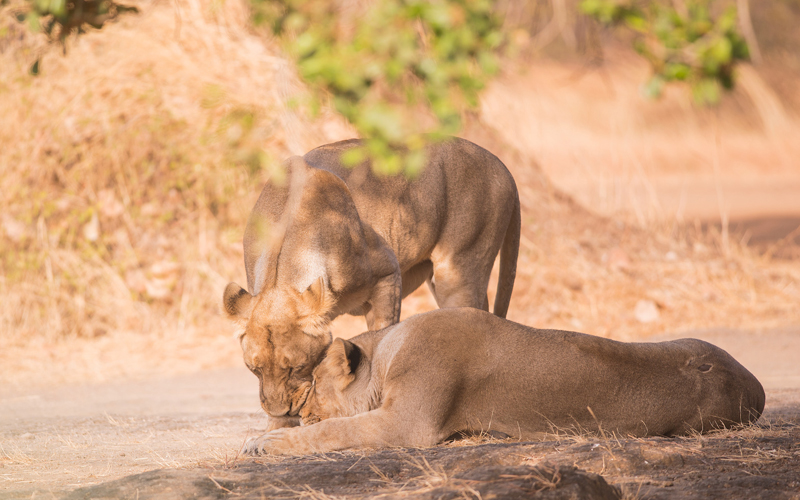
Gir National Park and Wildlife Sanctuary is the only remaining home for the Asiatic Lions. Located in Talala Gir in Gujarat, the Sanctuary is a part of Kathiawar- Gir dry deciduous forests ecoregion.
Gir provides you with the unique experience of visiting a place which almost singularly plays a crucial and defining role in the preservation and sustaining of a certain species. The preservation of these lions was initiated by the Nawab of Junagadh when these were just about to enter the phase of extinction due to hunting.
Other important wildlife forms found here are leopard, chausingha, spotted deer, hyena, sambar deer and chinkara.
The Town of the Lord of the Moon - Somnath Tourism
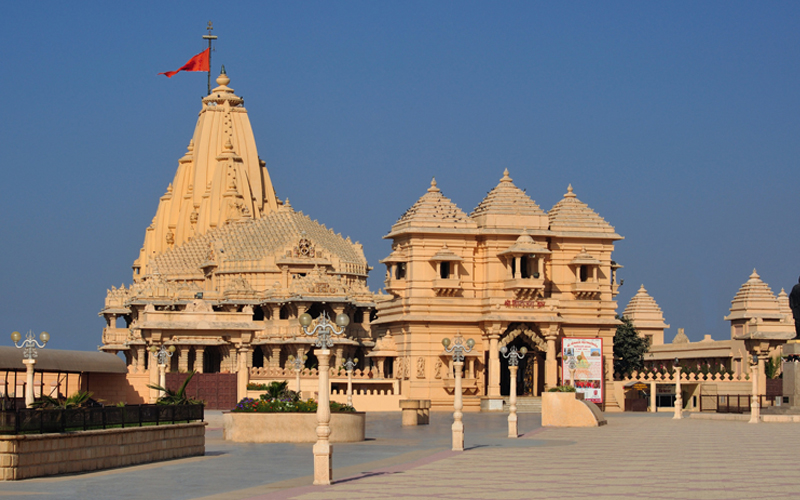
Somnath, literally meaning ‘lord of the moon’ is a pilgrim center and is home to one of the 12 Jyotirlingas. It is a town which derives much of its identity from the mythology, religion, and legends that surround it.
Primarily a temple town, Somnath is a place where a strong scent of religion and legends lingers around tourism and even daily life. Its spiritual environment is ornamented by the huge number of temples in the area, however, Somnath also offers beaches, museums and other attractions. While the Somnath temple and Somnath beach are the primary places to visit here, Gita Mandir, Balukha Tirtha, Kamnath Mahadev Temple, Somnath Museum are some of the other places that one can visit.
Vadodara Tourism

Vadodara or Baroda is a cosmopolitan city located in Gujarat. Home to some of the most exemplary displays of architecture, Vadodara is a fitting memorial to Maratha leader Sayaji Rao Gaekwad III who had envisioned a dream to make this Big City an educational, industrial and commercial centre.
Known for one of the most lavish palaces in India- the Lakshmi Vilas Palace and plenty more legendary monuments, Vadodara is the cultural capital of Gujarat.
The Abode of Serpents - Saputara Tourism

Snuggled in the Sahyadris or the Western Ghats, Saputara is a quaint little hill station in the Dang district of Gujarat. Popular for lush green forests, undulating mountains, dazzling waterfalls, dreamy winding roads, livid landscapes and plenty of charming cubbyholes to spend time with your loved ones, the town is the first favourite among tourists. It is located at a height of 875 metres above sea level and is a perfect getaway for eco-lovers, wildlife enthusiasts and people who love adventure sports.
Saputara literally means habitat of snakes and the tribals of this region worship snakes, especially during Holi. It is a beautiful hilly region enriched with enormous greenery offering magnificent panaroma, tribal culture of a different sort and great trekking opportunities.
You can also refer to the Gujarat Tourism official website https://www.gujarattourism.com for any further information required.
Statue of Unity
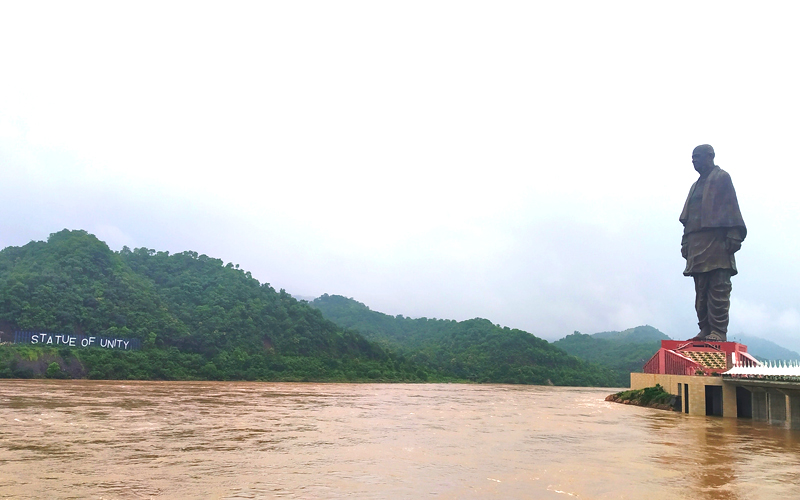
Statue of Unity is a memorial to The Iron Man of India, Sardar Vallabhbhai Patel. The statue has been erected to propagate Sardar Vallabhbhai Patel’s vision of India and to inspire the Citizens of India through his patriotism and freedom struggle. The Bronze statue of the founding father of the Republic of India stands 182 metres tall grabbing the attention of the whole world as the ‘Tallest statue in the World’. The statue of Unity is Located in Gujrat, by the banks of River Narmada on the River Island of Sadhu Bet overlooking the Narmada Dam (Sardar Sarovar Dam) from 3.2 km away.
The Statue of Unity will be well connected via expressways, improved rail system and helipads for the convenience of visitors. The surrounding of the statue is proposed to be a haven for clean Industries, Research facilities and educational institutions to improve the economic integrity in and around the region.
BlackBuck National Park, Velavadar
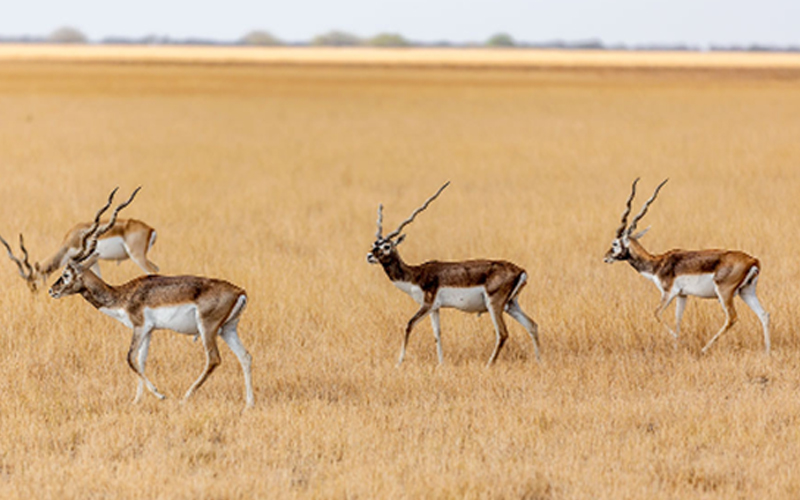
This beautiful, 34-sq-km park that is an hour’s drive north of Bhavnagar, encompasses large areas of pale, custard-coloured grassland stretching between two seasonal rivers and is famous for its blackbucks – beautiful, fast antelope that sport elegant spiraling horns as long as 65cm in mature males. Some 1800 inhabit the park, alongside blue bulls (India’s largest antelope) and birds such as wintering harriers from Siberia (about 2000 of them most years). There are over 120 species of birds that can be found in the park and around. If you’re lucky, you may even spot wolves! The best time to visit the sanctuary is early in the morning when chances of seeing the wolves are a lot more. In the day, the blackbucks are easy to spot but the wolves are elusive. The pale gold grassland is dotted with clusters of blackbucks. They move around in gendered groups – the males together, and the females and fawns in their own groups. It is good that hiring a guide is mandatory as anecdotes about the animals and life in the village are always fun to know more about.
Sun Temple of Modhera
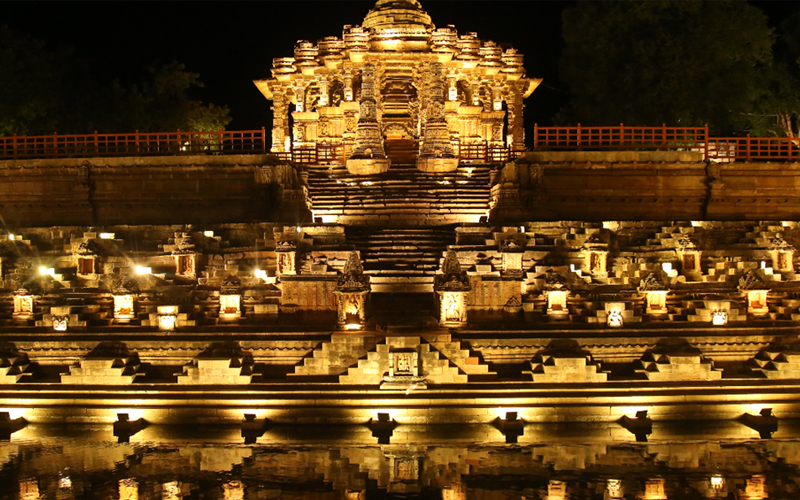
As one traverses the length and breadth of Gujarat, one constantly stumbles across architectural legacies of the ‘Solanki’ rule. You keep coming across living spaces and monuments of another time, offering an eclectic glimpse of the artistic and ingenious beauty that makes this exotically state vibrant.
A soothing drive amidst green farmlands almost 25 km away from Mehsana on the way to the temples of goddess Bahucharaji reposes the village of Modhera. Set along the backdrop of River Pushpavati, surrounded by a terra-formed garden of flowering trees and songs of birds, rests the famed Sun temple of Modhera.
The remains of the Sun Temples at Modhera dedicated to sun god are relics of times gone by when reverence of the natural elements fire, air, earth, water and sky were at their peak sharing space with myriad manifestations of Vedic gods. The ancient philosophy venerating natural elements and its association with humans was considered the prime force and energy of the life cycle. A walk around the serene temple campus makes you aware of the positively strong aura of energy which the place radiates and through it brings one closer to the environs.
Adding the beauty in this already famous popular Modhera Sun Temple. In October, 2022 Honorable Prime Minister Shri Narendrabhai Modi Inaugurated Solar powered 3-D Projection Mapping Show and Heritage Lighting at the Temple. Which is one of a kind experience. It has added another feather in the cap of this already well known temple.
Champaner Pavagadh, Archaeological Park, In Champaner Gujarat

A UNESCO Heritage site, Champaner and Pavagadh are often clubbed together as one of the most engaging historical attractions of Gujarat. Pavagadh stands on top of the hill that looks over the sprawl of monuments at the base in Champaner. The duo makes a rich heritage site dotted with forts, mosques, monuments, tombs, arches, temples, step-wells and fortresses from 8th to 14th century. Today, throngs of pilgrims ascend Pavagadh to worship at the important Kalikamata Temple, dedicated to the goddess Kali, who sits atop the summit. Champaner is the only unchanged Islamic-Mughal city over the centuries, offering an authentic flavour of architecture of the era. Juxtaposed to this is the Kalika Mata Temple on the Pavagadh Hill, where thousands congregate during Navratris.
At the heart of Champaner, is the Citadel, whose most impressive features are its 16th-century monumental mosques (no longer used for worship), with their beautiful blending of Islamic and Hindu architecture. The huge Jami Masjid, just outside the Citadel’s east gate, boasts of a wonderful carved entrance porch that leads into a lovely courtyard surrounded by a pillared corridor. The prayer hall has two tall central minarets, further superb stone carving, multiple domes, finely latticed windows and seven mihrabs (prayer niches) along the back wall.
Other beautiful mosques include the Saher ki Masjid, behind the ticket office inside the Citadel, which was probably the private royal mosque, and the Kevda Masjid, 300m north of the Citadel and about 600m west of the Jami Masjid. Here you can climb narrow stairs to the roof, and higher up the minarets, to spot other mosques even further out into the countryside – Nagina Masjid, 500m north, with no minarets but exquisite geometric carving, particularly on the tomb next to it, and Lila Gumbaj ki Masjid, 800m east, on a high platform and with a fluted central dome. The twin minarets resembling factory chimneys, about 1 km west, adorn the Brick Minar ki Masjid, a rare brick tomb.
Patan Patola weaving, Patan
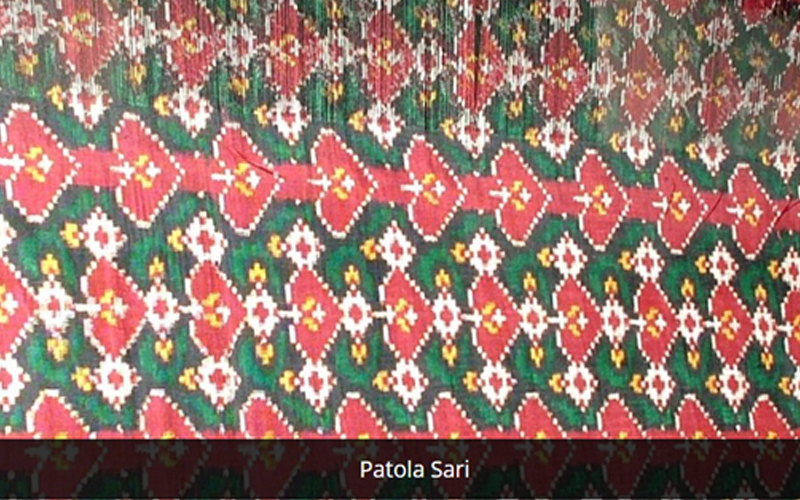
Patola is a double ikat woven sari, usually made from silk, made in Patan, Gujarat, India. The word patola is the plural form; the singular is patolu. They are very expensive, once worn only by those belonging to royal and aristocratic families. These saris are popular among those who can afford the high prices. Velvet patola styles are also made in Surat. Patola-weaving is a closely guarded family tradition. There are three families in Patan that weave these highly prized double ikat saris. It is said that this technique is taught to no one in the family, but only to the sons. It can take six months to one year to make one sari due to the long process of dying each strand separately before weaving them together.Patola was woven in Surat, Ahmedabad and Patan.
Rani ki Vav
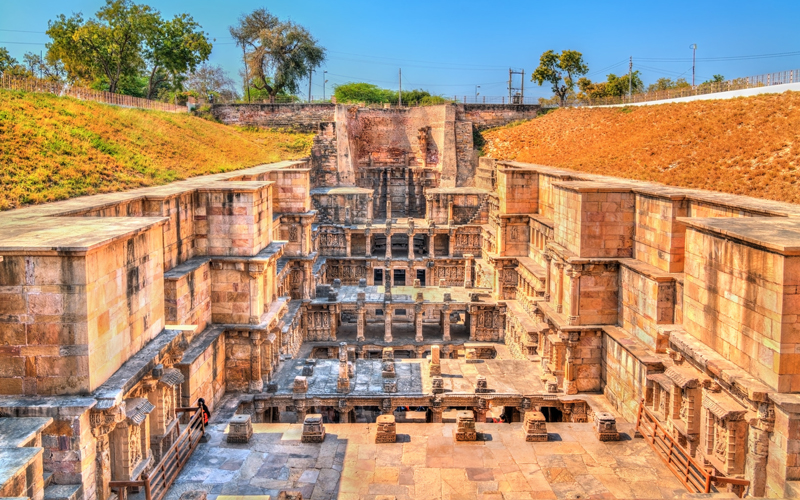
Rani Ki Vav or ‘Queen’s Stepwell’ is a distinctive form of water storage system located in the small town of Gujarat called Patan, on the banks of River Saraswati. Believed to be the grandest stepwell in the state of Gujarat, Rani ka Vav epitomises the peak of Maru-Gujarat architectural style. The 900-year-old structure listed as a UNESCO World Heritage Site is displayed prominently in the new ₹ 100 currency note issued by the Reserve Bank of India.
In the olden days, the water of the well had medicinal properties which helped ward off diseases like viral diseases and fever. The well was excavated in the 1960s in a well-protected state as it was buried under slit for sanctuaries. In addition to this, Rani Ka Vav was an important centre for socializing among the locals as well as taking refuge from the heat. It’s an excellent example of turning something functional into a piece of art.

